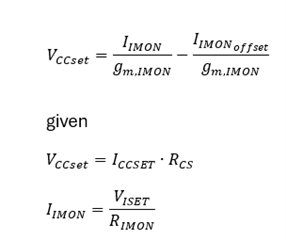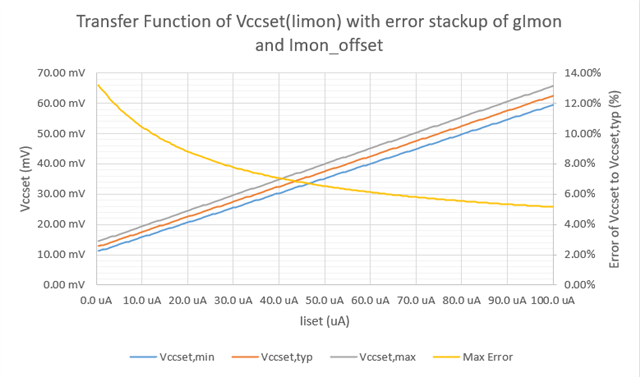Other Parts Discussed in Thread: LM5170
Tool/software:
Hello!
I'm working on a design using the LM5190. One of the reasons we selected this part is the tight current regulation accuracy (+/- 3%) advertised on the first page of the datasheet and on the product page. However, diving into the datasheet I'm having trouble understanding where that number comes from, as my analysis is showing the tolerance may vary quite a bit, especially if lower than full-scale (for instance in an application where ISET is driven by a DAC).
According to the datasheet in equation 11 (page 21):

Rearranging this equation to solve for Icc,set I get:

From the datasheet specification tables on page 7 section 5.5 we can see

However, doing a worst case analysis with just those two terms (ie assuming Rcs and Rimon are perfect, I can only get close to +/-3% error full scale when setting Rimon to a very low value (1200 ohms or less), and even then the error can get quite large at currents less than the full scale.
Even if I were to define that 3% current setpoint accuracy as a percentage of full scale, I'm not sure that can be practically realized. The recommendation from the design tool is to keep DAC driven ISET values at or below 800mV, and if this is scaled to full scale this causes significant issues.
To help show my point, I am going to refactor the above equation to Vccset(Imon).

This way I can show just the effects of the error terms of gm_imon and Iimon_offset. Doing an extreme value analysis with the above datasheet values, I get:

This implies that the Imon pin can never be more than ~5.13% accurate at full scale.
My questions are:
- Is it accurate that the +/- 3% current setpoint accuracy is meant to be in terms of full scale range?
- Is the current setpoint accuracy +/- 3%, or is it less as shown by above analysis?
- Are there constraints required to Rimon and Rcs beyond what is shown in the datasheet and the design tool required to get that accuracy?

